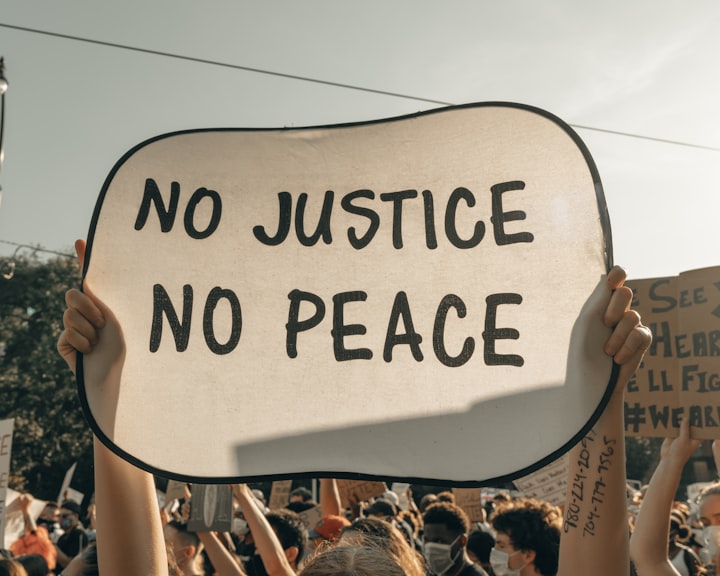How Dangerous is it to be Black and LGBT+?
Something important to focus on this Pride Month

This month has been full of protests, activism and politics. I want to take this opportunity to gather some information and stats on what it's like to be black and part of the LGBT+ community. Being LGBT+ can already be extremely challenging for a lot of people, but statistics show it can be even harder if you're black. I'm not disregarding the fact that it can be challenging and dangerous for people from any race, but today I'm specifically focusing on the black community.
Discrimination
The world is slowly becoming more accepting towards LGBT+ people, but the black community generally receives less acceptance than the rest. In Claire Gecewicz's article Blacks are lukewarm to gay marriage, but most say businesses must provide wedding services to gay couples, there are stats that say that 61% of white gays and lesbians endure discrimination, whilst for African Americans the number is a staggering 80%. Black people often have to endure double discrimination, adding racism on top of the transphobia and homophobia they already face. According to Stonewall, over half of the BAME (Black, Asian, and minority ethnic) LGBT+ members face discrimination within the community itself. Three in five black members have experienced discrimination from other people in the community. These numbers are uncomfortably high, and show that we have a long way to go. We should all check in on ourselves and think about our attitudes and how we treat other people.
Hate crimes
People who are in the LGBT+ community are at a greater risk of experiencing hate crime than heterosexual people are, and black people are at particular risk. We constantly hear about black people who have been attacked and even killed because of who they are, so it's a well known fact that being black and LGBT+ is dangerous. Statistics from the Human Rights Campaign (HRC) show that more than one transgender person is killed every month in the US, and there are dark numbers here as well as it's difficult to collect data on the topic. Victims are often misgendered in media and reports, making it harder to identify the cases as anti-transgender crimes. They are also sometimes ruled suicides, although evidence clearly shows otherwise. The murders are horrific and gruesome, and high percentages of the victims are people of colour. Black transgender women are of the highest risk, and are disproportionately represented in statistics. Sadly, because of common experiences of revictimization by law enforcement, including harassment and violence, they are less likely to report the incidents.
Mental health
Members of the LGBT+ community have higher chances of developing mental health issues. This can be caused by a variety of reasons, such as homophobia, isolation and discrimination. The Mental Health Foundation states that they are more likely to experience issues such as depression, self-harm, suicidal thoughts and alcohol and substance abuse. Such large numbers of BAME LGBT+ people facing discrimination within the community often leaves them feeling excluded, especially as many of them don't receive support from their families or friends. Sadly, because of cultural gender expectations and prevalent homophobia, many black people are hesitant to come out to their families. A Pew Research Center survey shows that seven in ten African Americans say that homosexual behaviour is a sin. Black members of the LGBT+ community face a disproportionate amount of homophobic violence, abuse and harassment. This doesn't help their increased risk of poor mental health, as many of them can't turn to the LGBT+ community nor their ethnic community for support, as they face discrimination in both of them. On top of this it's hard for them to find support elsewhere as well.
In Stonewall's LGBT in Britain Health Report, 8% of BAME LGBT+ people attempted to take their own life in 2017. Furthermore, 22% of them had experienced an eating disorder, 18% had difficulties accessing healthcare services and 19% have avoided treatment for fear of discrimination. Many people in the survey say they've experienced a lack of understanding, and 19% have experienced unequal treatment from healthcare staff because they are LGBT+. A shocking 27% aren't out to anyone about their sexual orientation. According to an article by HRC, Black and African American LGBT+ youth find it difficult to open up. Only ten percent of the people surveyed would be very comfortable discussing their LGBT+ identity with a counsellor. They have to deal with numerous stressors such as harassment and rejection from their peers, bullying and isolation and the fear of their family rejecting them. Eight in ten of them rate their average stress to a level five or higher on a ten point scale. 80% of them usually feel depressed or down. 71% feel worthless or hopeless. 80% feel worried, nervous or panicked. The numbers are taken from HRC's African American 2019 LGBTQ Youth Report, and clearly show how important it is to ensure access to safe mental health services for everyone.
Black and transgender
The LGBT+ community has been fighting for equality for a long time, but especially for transgender people it's also a fight for survival. According to HRC's article about violence against the transgender community, there were 26 tracked murders of transgender or gender non-conforming people in the US in 2018. The majority of them were black transgender women, killed by their friends, partners or strangers. Only some of them have been arrested and charged. It's a difficult topic to collect data on, so it's hard to produce accurate numbers on how many people are attacked each year, but the numbers are too high regardless. Black transgender people are met with heavy discrimination in many areas of life, such as education, employment and health care. Because of the discrimination and rejection they face, many of them turn to survival sex work to get by. This increases their vulnerability and exposes them to more risks for violence. At least between 18 and 34% of transgender people killed in 2015 in the US were most likely engaged in sex work at the time of their deaths. This strongly pictures their heightened vulnerability and risks, as being excluded often puts them in difficult and dangerous situations. Many lives can be saved by creating a more inclusive society.
We must all put in consistent work to help the LGBT+ community, whether you are a member of it or an ally. Always challenge homophobia and transphobia if and when you see it. People shouldn't be punished for being "different", they should be embraced and encouraged to be themselves, and feel safe enough to do so.
"If we are honest with ourselves, we'll acknowledge that our own community has not always been true to Martin Luther King's vision of a beloved community ... We have scorned our gay brothers and sisters instead of embracing them."
- Barack Obama
----------------------------------------------------------------------------------------
If you enjoyed this article, please share it on your social media and send it to someone you think will like it too!
If you enjoyed this article and would like to support me, you can send me a tip below this story, which would be greatly appreciated.
Thank you so much for your support!
About the Creator
Tone Breistrand
Hi there! I am a Norwegian writer living in London. I like to write about love, Disney and finding happiness.






Comments
There are no comments for this story
Be the first to respond and start the conversation.